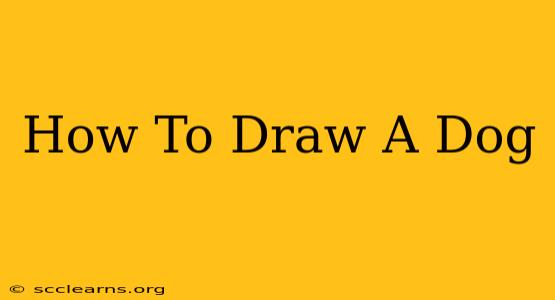Want to learn how to draw a dog? Even if you think you can't draw, this guide will show you how to create a charming canine companion on paper. We'll break down the process into simple, manageable steps, perfect for beginners and seasoned artists alike. Get ready to unleash your inner artist!
Understanding Dog Anatomy: The Foundation of Your Drawing
Before we start sketching, let's briefly touch upon basic dog anatomy. While we won't be dissecting a canine, understanding the underlying structure will help your drawing look more realistic and less like a blob!
Key Features to Consider:
- Head Shape: Dogs have a variety of head shapes – from the long muzzle of a Greyhound to the shorter, broader face of a Bulldog. Observe the specific breed you're drawing to get this right.
- Body Proportions: Pay attention to the relationship between the dog's head, body, and legs. Are they long and lean, or short and stocky?
- Ear Shapes: Dog ears come in countless variations – floppy, pointed, erect, cropped. Getting the ears right can significantly impact the breed's identification.
- Tail: The tail is a crucial element. Is it fluffy and long, short and stubby, or curled?
Step-by-Step Guide: Drawing a Simple Dog
Let's start with a simple, cartoonish dog. This will build your confidence and introduce fundamental drawing techniques.
Step 1: The Basic Shape
Begin by sketching a large circle for the dog's head. Then, attach a slightly elongated oval for the body, connecting it to the circle. This forms the foundational structure of your dog.
Step 2: Adding Features
Now, let's add some features. Draw two small circles for the eyes, positioned slightly below the top of the head circle. Add a small triangle for the nose, and a curved line for the mouth. Don't worry about perfection at this stage – it's all about getting the basic shapes right.
Step 3: Legs and Tail
Sketch four simple lines for the legs, extending downward from the body oval. Add a curved line for the tail, extending from the rear of the body. Adjust the length and shape of the legs and tail to match your desired dog breed.
Step 4: Refining the Details
This is where you add personality! Refine the shapes of the head, body, legs, and tail. Round out the edges, add fur texture using short, light strokes, and add details like toes and claws.
Step 5: Adding the Finishing Touches
Erase any unnecessary guide lines. Add shading to create depth and dimension. Darker areas will create the illusion of fur and form. Consider adding a background to further enhance your drawing.
Drawing More Realistic Dogs
Once you're comfortable with the basics, try drawing more realistic dogs. Observe real dogs, photos, or even videos to understand their anatomy and postures. Practice drawing different breeds, focusing on their unique features. Experiment with different drawing tools and techniques to discover your preferred style.
Tips for Success
- Practice Regularly: The key to improving your drawing skills is consistent practice.
- Use References: Look at photos of dogs to help you understand their proportions and features.
- Don't Be Afraid to Make Mistakes: Drawing is a process of trial and error. Learn from your mistakes and keep practicing.
- Have Fun!: Enjoy the process of creating your canine masterpiece!
By following these steps and practicing regularly, you'll be surprised at how quickly you can improve your ability to draw dogs. So grab your pencils and paper, and let's start creating! Remember to share your artwork with us – we'd love to see your canine creations!

